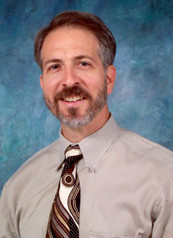 With the development of such prosthetic devices as artificial joints, mechanical heart valves and cerebral-spinal fluid shunts, doctors have an almost miraculous ability to save lives and restore function.
With the development of such prosthetic devices as artificial joints, mechanical heart valves and cerebral-spinal fluid shunts, doctors have an almost miraculous ability to save lives and restore function.
Unfortunately, one of the chief limitations of their use is infections.
“Biofilm-associated infections involving prosthetic medical devices are absolutely devastating complications resulting in loss of life, loss of function and loss of resources,” said Mark Rupp, M.D., UNMC professor of internal medicine and co-editor of a new textbook directed at understanding these important infections.
“Since the discovery of micro-organisms several hundred years ago, our characterization of the microbial world has largely concentrated on studying planktonic (free-living organisms). However, more recently, there has been an appreciation that most microbes live in sessile forms in biofilms,” Dr. Rupp said.
A biofilm is a community of micro-organisms associated with a surface and typically enveloped in a sticky, slimy, extracellular matrix. Examples of biofilm-associated infections include artificial-device infections, otitis (middle ear infections), and osteomyelitis (bone infections).
“A hallmark of biofilm-associated infections is their resistance to antibiotics. These infections are often very difficult to eradicate and the patient is often subjected to repeated surgical procedures,” Dr. Rupp said.
The textbook, titled “Biofilms, Infection and Antimicrobial Therapy,” is organized into 24 chapters written by 54 internationally recognized experts. Others at UNMC involved in the book include Paul Fey, Ph.D., UNMC associate professor, and Luke Handke, doctoral student, UNMC Department of Pathology and Microbiology.
“Staphylococcus epidermidis is the most frequent cause of biofilm-associated infections of medical devices,” Dr. Fey said. “Efforts in our lab are directed toward understanding the genetic regulation of biofilm formation in hopes of developing better ways to prevent and treat these significant infections.”
Dr. Rupp’s co-editors were John Pace, Ph.D., of Protez Pharmaceuticals, and Roger Finch, M.D., of Nottingham Hospital in the United Kingdom.
Dr. Rupp said he was pleased to be involved in the project: “I think this textbook is a great source of information for scientists and clinicians, alike,” he said. “It not only includes information regarding cutting-edge research, such as that performed in Dr. Fey’s lab, but also gives doctors practical advice on how to best treat these stubborn infections.”